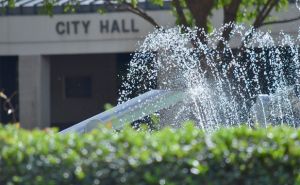The Senoia City Council on Monday night heard the first reading of the upcoming $2.1 million FY 2011 General Fund budget that takes effect in January. The second reading and likely approval will come in December.
The 2011 General Fund budget shows an increase in revenues totaling $24,600 over 2010, with revenues and expenditures each totaling $2,128,400.
Some of the budget categories that showed an increase included property taxes that are projected to increase by $77,200 as a result of limited construction during 2010, $3,000 in the rental of the Freeman Sasser facility and $27,000 from the recent sale of the old police department buildings to the Downtown Development Authority.
A number of budget categories showed a decrease in revenues over the current year, with many tied to the ongoing recession that continues to take a toll on development. Among those were a $22,000 projected decrease in zoning and land use revenues and $6,000 in business licenses.
City Administrator Richard Ferry in a presentation to the council noted the realities built in to the budget.
“The city has been challenged by the continuing slump in the housing market. The water and sewer funds rely heavily on meter taps and sewer connections to pay the loans on those system,” Ferry said. “Permits in FY 2010 have decreased almost 40 percent compared to FY 2009. Though the tax digest has grown because of new construction in 2008 and 2009, the assessed value of the property has contracted leaving a gap when trying to provide services for the new growth. The Local Option Sales Tax is projected to come in 10 percent under expected revenues and franchise fees are roughly 12 percent less than expected. However, if all spending trends hold through the end of the year, the overall budget should come in where revenues for the year nearly equal expenditures for the year.”
Ferry at the meeting also addressed the budgets for city’s water and sewer funds, both of which are balanced.
“In the FY 2011, water fund budget expenses are budgeted to increase by $91,000 or 13 percent. The vast majority of this is in the improvements to the water plant required by the Georgia EPD (Environmental Protection Division) and a staff transfer from the Street Department to assist with water needs,” said Ferry. “The budget cost of chemicals has been absorbed into the budget but is still significant and the replacement and retrofit of old meters to the new and more efficient Sensus Radio Read Meters. These costs and improvements are proposed to be met within the user fees and connection fees.”
Ferry said the sewer fund is one that will bear close scrutiny in the coming year, especially in terms of the amount of debt service payments on the system.
“The sewer fund is met with increasing costs and decreasing user fees,” Ferry said. “Though I don’t see this as a good solution, the only line item that has any flexibility is employees. There are only 3 full-time workers in the department. Most of the other line items are necessary to maintain the system. These include utility costs over $100,000, mandated testing and professional reports for EPD. Of the $648,800 budget, $319,900, or 48 percent, is for debt service. Though tap fees and connection fees can be used for system maintenance and operation, these fees should be put toward planning, growth and retiring debt. At this point they are clearly paying for operations. I am recommending that (consulting engineering firm) Turnipseed is contacted in January to review Sewer Rates to meet the costs of maintaining the system.”












Leave a Comment
You must be logged in to post a comment.